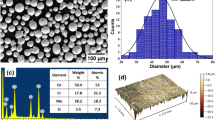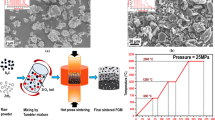Methods have been developed for weakening and removing ceramic rods from a metal casting by means of polymorphic transformations in cristobalite and β-Ca2SiO4 during vibration in water containing surfactants without the use of aggressive and environmentally harmful reagents. The hot-bending strength (at 1050°C) of ceramic made from cristobalite was about 20 MPa while that of β-Ca2SiO4 at 1300°C was 18 – 24 MPa, which is adequate for use as a rod material. The use of carbamide formaldehyde resin with silicate sol as a binder for powders made from tridimite, mullite and zircon made it possible to weaken the rods, on cooling, as a result of polymorphism of cristobalite. The weakening and removal of the rods during vibration in water containing a surfactant was achieved with a polymorphic transformation from β-Ca2SiO4 into γ-Ca2SiO4 in mixes made from MgO, α-Al2O3, fused SiO2 and stabilized ZrO2.



Similar content being viewed by others
References
E. N. Kablov (ed.), Cast Blades for Gas-Turbine Engines: Alloys, Technology, Coatings [in Russian], Nauka, Moscow (2006).
I. K. Moroz and G. N. Maslennikova, “Thermal transformations in silica,” Steklo Keram., No. 12, 21 – 23 (1985); I. K. Moroz and G. N. Maslennikova, “Thermal transformations in silica (review),” Glass Ceram., 42(12), 559 – 564 (1985).
E. I. Suzdal’tsev, “Study of the aging process in quartz ceramic,” Ogneupory, No. 1, 28 – 32 (1986).
V. F. Tsarev, L. V. Lavrent’eva, and M. G. Zolotareva, “Effect of alkaline and alkaline-earth metal additions on the properties of quartz ceramic,” Steklo Keram., No. 3, 22 – 24 (1985); V. F. Tsarev, L. V. Lavrent’eva, and M. G. Zolotareva, “Influence of impurities in oxides of alkalis and alkaline earth metals on the properties of quartz ceramics,” Glass Ceram., 42(3), 164 – 167 (1985).
N. I. Sinel’nikov, “Role of the solid phase for tridimitization of quartz,” Zh. Neorg. Khim., 4(12), 2727 – 2731 (1959).
G. V. Batalova, A. V. Belyakov, V. N. Drogin, et al., “Conditions for molding ceramics containing polyorganic siloxane binder,” Steklo Keram., No. 2, 17 – 18 (1980); G. V. Batalova, V. N. Drogin, A. S. Vlasov, et al., “Conditions of shaping ceramics with a polyorganosiloxane binder,” Glass Ceram., 37(2), 86–88 (1985).
A. V. Belyakov, “Polymorphism in dicalcium silicate and oxygen vacancies,” Tsement Ego Primenenie, No. 1, 27 – 30 (1999).
We wish to express our gratitude to Candidate of Technical Sciences T. N. Shestoperova for her enormous assistance in performing the experiments and analyzing the results.
Author information
Authors and Affiliations
Corresponding author
Additional information
Translated from Steklo i Keramika, No. 4, pp. 26 – 31, April, 2012.
Rights and permissions
About this article
Cite this article
Belyakov, A.V., Razumnova, I.V., Demonis, I.M. et al. Easily removed ceramic rods for casting gas-turbine engine blades using molding patterns. Glass Ceram 69, 125–129 (2012). https://doi.org/10.1007/s10717-012-9429-x
Published:
Issue Date:
DOI: https://doi.org/10.1007/s10717-012-9429-x




